China's Population Crisis: Challenges and Future Implications
VerifiedAdded on 2021/06/15
|9
|2713
|93
Essay
AI Summary
This essay examines China's population crisis, highlighting its causes, including an aging population and the impacts of past government policies like the one-child policy. The essay explores the economic consequences, such as potential labor shortages and the strain on industries, alongside social and climatic effects. It analyzes the disparities between urban and rural populations and the government's attempts to mitigate the crisis through policies like the two-child policy. The author argues that the crisis poses significant challenges to China's future, affecting its economic framework, industrial growth, and environmental sustainability, and emphasizes the need for effective measures to address these issues. The essay concludes by underscoring the multifaceted nature of the crisis and its potential long-term effects on Chinese society and its global standing.
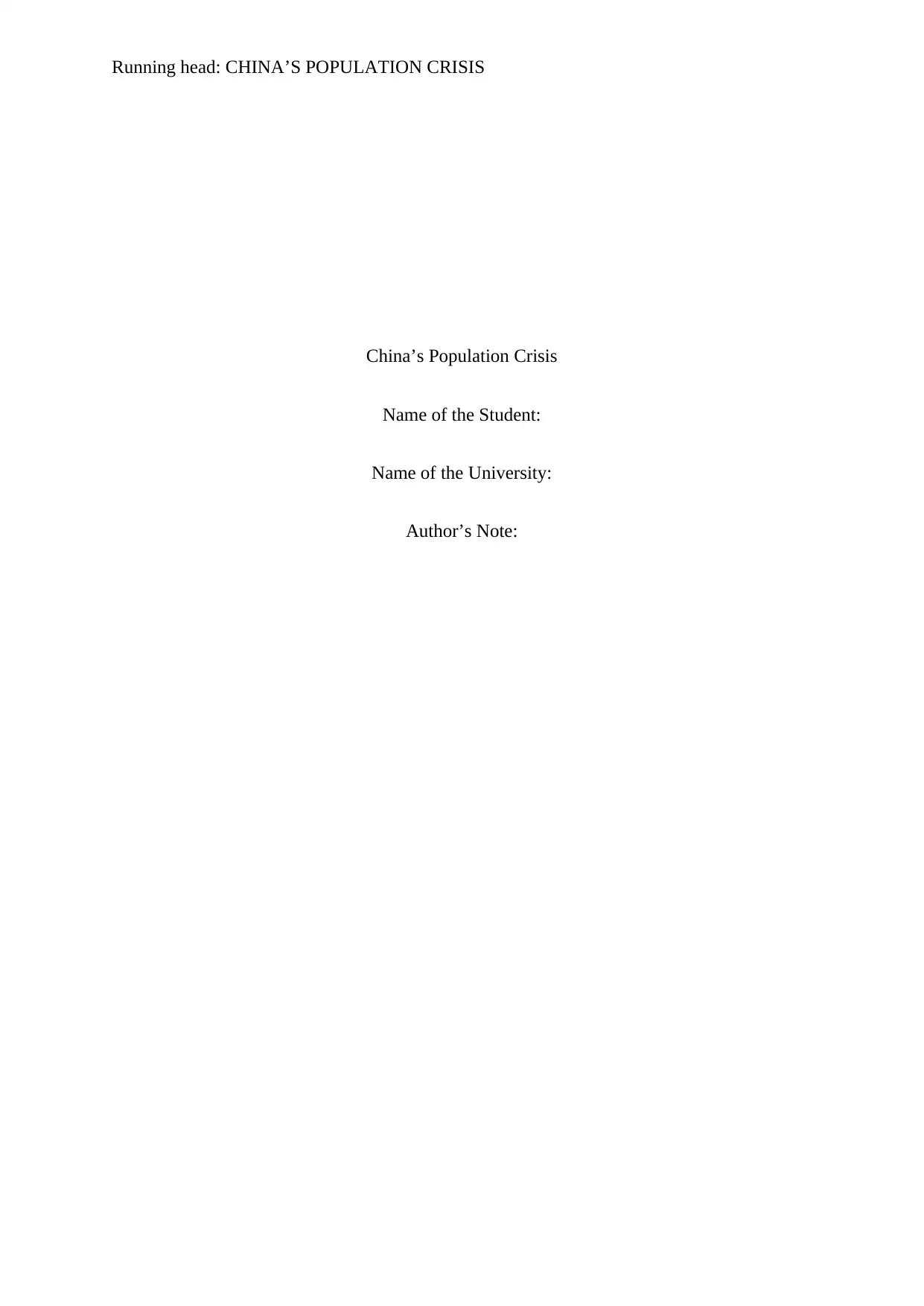
Running head: CHINA’S POPULATION CRISIS
China’s Population Crisis
Name of the Student:
Name of the University:
Author’s Note:
China’s Population Crisis
Name of the Student:
Name of the University:
Author’s Note:
Paraphrase This Document
Need a fresh take? Get an instant paraphrase of this document with our AI Paraphraser
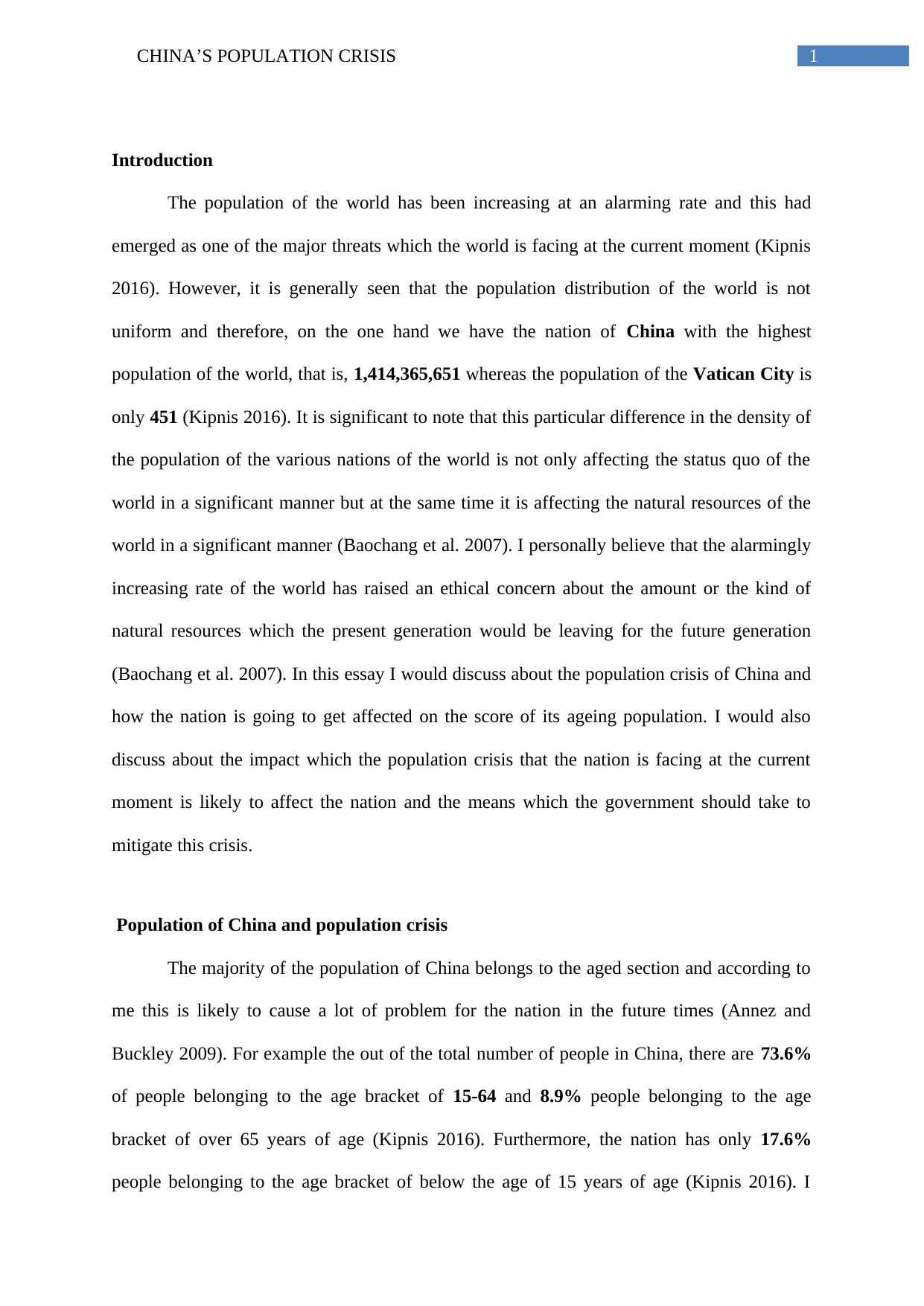
1CHINA’S POPULATION CRISIS
Introduction
The population of the world has been increasing at an alarming rate and this had
emerged as one of the major threats which the world is facing at the current moment (Kipnis
2016). However, it is generally seen that the population distribution of the world is not
uniform and therefore, on the one hand we have the nation of China with the highest
population of the world, that is, 1,414,365,651 whereas the population of the Vatican City is
only 451 (Kipnis 2016). It is significant to note that this particular difference in the density of
the population of the various nations of the world is not only affecting the status quo of the
world in a significant manner but at the same time it is affecting the natural resources of the
world in a significant manner (Baochang et al. 2007). I personally believe that the alarmingly
increasing rate of the world has raised an ethical concern about the amount or the kind of
natural resources which the present generation would be leaving for the future generation
(Baochang et al. 2007). In this essay I would discuss about the population crisis of China and
how the nation is going to get affected on the score of its ageing population. I would also
discuss about the impact which the population crisis that the nation is facing at the current
moment is likely to affect the nation and the means which the government should take to
mitigate this crisis.
Population of China and population crisis
The majority of the population of China belongs to the aged section and according to
me this is likely to cause a lot of problem for the nation in the future times (Annez and
Buckley 2009). For example the out of the total number of people in China, there are 73.6%
of people belonging to the age bracket of 15-64 and 8.9% people belonging to the age
bracket of over 65 years of age (Kipnis 2016). Furthermore, the nation has only 17.6%
people belonging to the age bracket of below the age of 15 years of age (Kipnis 2016). I
Introduction
The population of the world has been increasing at an alarming rate and this had
emerged as one of the major threats which the world is facing at the current moment (Kipnis
2016). However, it is generally seen that the population distribution of the world is not
uniform and therefore, on the one hand we have the nation of China with the highest
population of the world, that is, 1,414,365,651 whereas the population of the Vatican City is
only 451 (Kipnis 2016). It is significant to note that this particular difference in the density of
the population of the various nations of the world is not only affecting the status quo of the
world in a significant manner but at the same time it is affecting the natural resources of the
world in a significant manner (Baochang et al. 2007). I personally believe that the alarmingly
increasing rate of the world has raised an ethical concern about the amount or the kind of
natural resources which the present generation would be leaving for the future generation
(Baochang et al. 2007). In this essay I would discuss about the population crisis of China and
how the nation is going to get affected on the score of its ageing population. I would also
discuss about the impact which the population crisis that the nation is facing at the current
moment is likely to affect the nation and the means which the government should take to
mitigate this crisis.
Population of China and population crisis
The majority of the population of China belongs to the aged section and according to
me this is likely to cause a lot of problem for the nation in the future times (Annez and
Buckley 2009). For example the out of the total number of people in China, there are 73.6%
of people belonging to the age bracket of 15-64 and 8.9% people belonging to the age
bracket of over 65 years of age (Kipnis 2016). Furthermore, the nation has only 17.6%
people belonging to the age bracket of below the age of 15 years of age (Kipnis 2016). I
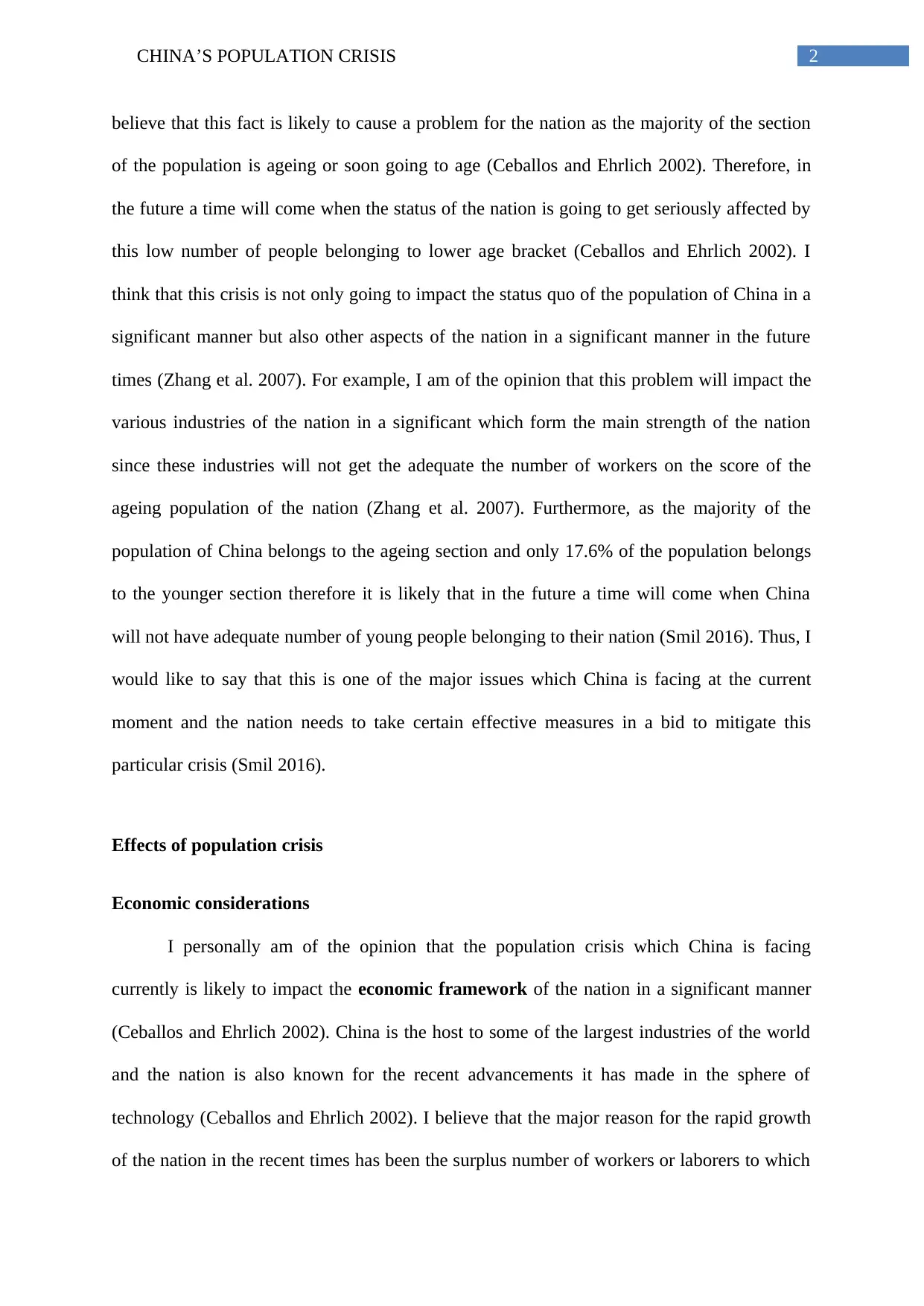
2CHINA’S POPULATION CRISIS
believe that this fact is likely to cause a problem for the nation as the majority of the section
of the population is ageing or soon going to age (Ceballos and Ehrlich 2002). Therefore, in
the future a time will come when the status of the nation is going to get seriously affected by
this low number of people belonging to lower age bracket (Ceballos and Ehrlich 2002). I
think that this crisis is not only going to impact the status quo of the population of China in a
significant manner but also other aspects of the nation in a significant manner in the future
times (Zhang et al. 2007). For example, I am of the opinion that this problem will impact the
various industries of the nation in a significant which form the main strength of the nation
since these industries will not get the adequate the number of workers on the score of the
ageing population of the nation (Zhang et al. 2007). Furthermore, as the majority of the
population of China belongs to the ageing section and only 17.6% of the population belongs
to the younger section therefore it is likely that in the future a time will come when China
will not have adequate number of young people belonging to their nation (Smil 2016). Thus, I
would like to say that this is one of the major issues which China is facing at the current
moment and the nation needs to take certain effective measures in a bid to mitigate this
particular crisis (Smil 2016).
Effects of population crisis
Economic considerations
I personally am of the opinion that the population crisis which China is facing
currently is likely to impact the economic framework of the nation in a significant manner
(Ceballos and Ehrlich 2002). China is the host to some of the largest industries of the world
and the nation is also known for the recent advancements it has made in the sphere of
technology (Ceballos and Ehrlich 2002). I believe that the major reason for the rapid growth
of the nation in the recent times has been the surplus number of workers or laborers to which
believe that this fact is likely to cause a problem for the nation as the majority of the section
of the population is ageing or soon going to age (Ceballos and Ehrlich 2002). Therefore, in
the future a time will come when the status of the nation is going to get seriously affected by
this low number of people belonging to lower age bracket (Ceballos and Ehrlich 2002). I
think that this crisis is not only going to impact the status quo of the population of China in a
significant manner but also other aspects of the nation in a significant manner in the future
times (Zhang et al. 2007). For example, I am of the opinion that this problem will impact the
various industries of the nation in a significant which form the main strength of the nation
since these industries will not get the adequate the number of workers on the score of the
ageing population of the nation (Zhang et al. 2007). Furthermore, as the majority of the
population of China belongs to the ageing section and only 17.6% of the population belongs
to the younger section therefore it is likely that in the future a time will come when China
will not have adequate number of young people belonging to their nation (Smil 2016). Thus, I
would like to say that this is one of the major issues which China is facing at the current
moment and the nation needs to take certain effective measures in a bid to mitigate this
particular crisis (Smil 2016).
Effects of population crisis
Economic considerations
I personally am of the opinion that the population crisis which China is facing
currently is likely to impact the economic framework of the nation in a significant manner
(Ceballos and Ehrlich 2002). China is the host to some of the largest industries of the world
and the nation is also known for the recent advancements it has made in the sphere of
technology (Ceballos and Ehrlich 2002). I believe that the major reason for the rapid growth
of the nation in the recent times has been the surplus number of workers or laborers to which
⊘ This is a preview!⊘
Do you want full access?
Subscribe today to unlock all pages.

Trusted by 1+ million students worldwide
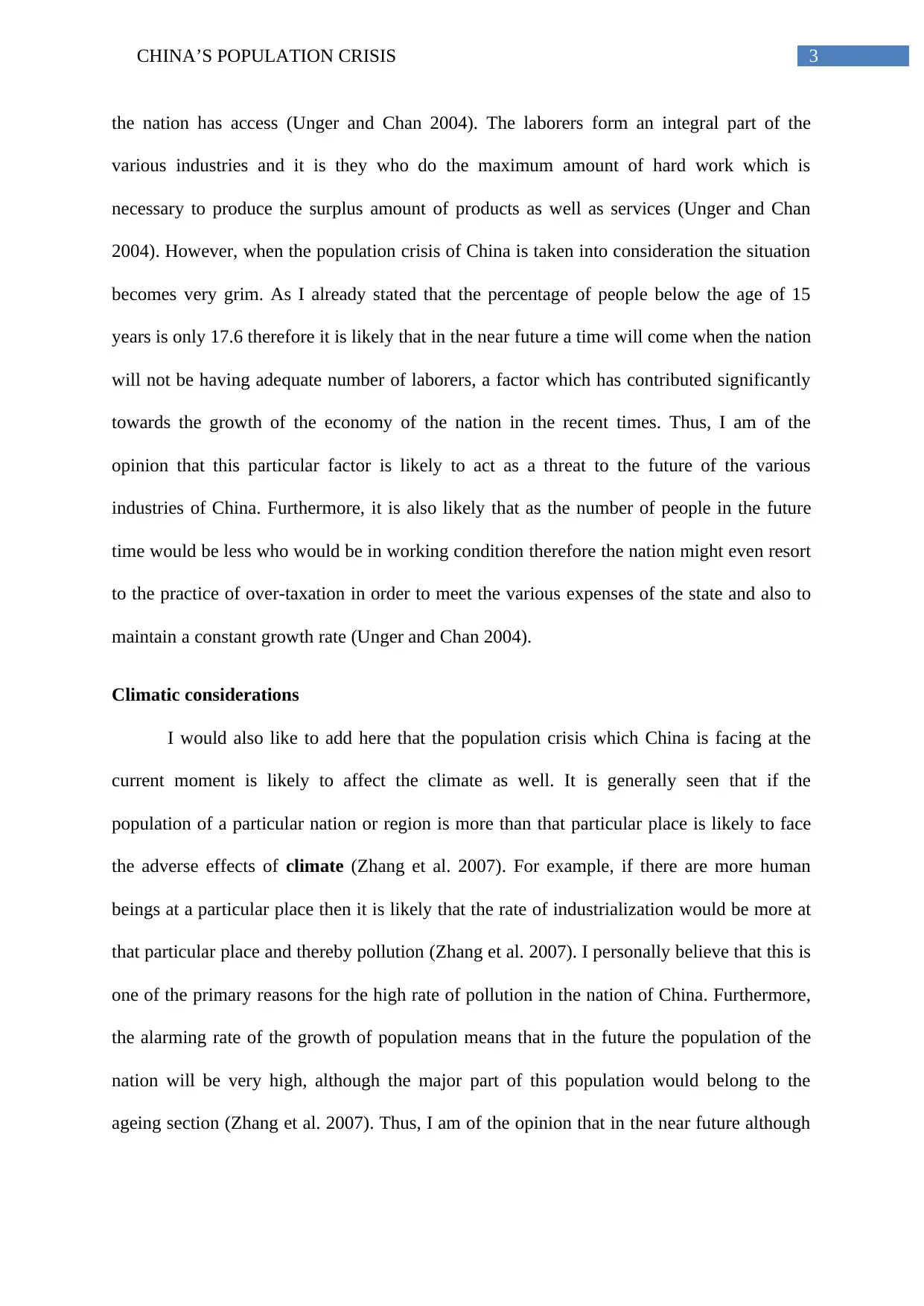
3CHINA’S POPULATION CRISIS
the nation has access (Unger and Chan 2004). The laborers form an integral part of the
various industries and it is they who do the maximum amount of hard work which is
necessary to produce the surplus amount of products as well as services (Unger and Chan
2004). However, when the population crisis of China is taken into consideration the situation
becomes very grim. As I already stated that the percentage of people below the age of 15
years is only 17.6 therefore it is likely that in the near future a time will come when the nation
will not be having adequate number of laborers, a factor which has contributed significantly
towards the growth of the economy of the nation in the recent times. Thus, I am of the
opinion that this particular factor is likely to act as a threat to the future of the various
industries of China. Furthermore, it is also likely that as the number of people in the future
time would be less who would be in working condition therefore the nation might even resort
to the practice of over-taxation in order to meet the various expenses of the state and also to
maintain a constant growth rate (Unger and Chan 2004).
Climatic considerations
I would also like to add here that the population crisis which China is facing at the
current moment is likely to affect the climate as well. It is generally seen that if the
population of a particular nation or region is more than that particular place is likely to face
the adverse effects of climate (Zhang et al. 2007). For example, if there are more human
beings at a particular place then it is likely that the rate of industrialization would be more at
that particular place and thereby pollution (Zhang et al. 2007). I personally believe that this is
one of the primary reasons for the high rate of pollution in the nation of China. Furthermore,
the alarming rate of the growth of population means that in the future the population of the
nation will be very high, although the major part of this population would belong to the
ageing section (Zhang et al. 2007). Thus, I am of the opinion that in the near future although
the nation has access (Unger and Chan 2004). The laborers form an integral part of the
various industries and it is they who do the maximum amount of hard work which is
necessary to produce the surplus amount of products as well as services (Unger and Chan
2004). However, when the population crisis of China is taken into consideration the situation
becomes very grim. As I already stated that the percentage of people below the age of 15
years is only 17.6 therefore it is likely that in the near future a time will come when the nation
will not be having adequate number of laborers, a factor which has contributed significantly
towards the growth of the economy of the nation in the recent times. Thus, I am of the
opinion that this particular factor is likely to act as a threat to the future of the various
industries of China. Furthermore, it is also likely that as the number of people in the future
time would be less who would be in working condition therefore the nation might even resort
to the practice of over-taxation in order to meet the various expenses of the state and also to
maintain a constant growth rate (Unger and Chan 2004).
Climatic considerations
I would also like to add here that the population crisis which China is facing at the
current moment is likely to affect the climate as well. It is generally seen that if the
population of a particular nation or region is more than that particular place is likely to face
the adverse effects of climate (Zhang et al. 2007). For example, if there are more human
beings at a particular place then it is likely that the rate of industrialization would be more at
that particular place and thereby pollution (Zhang et al. 2007). I personally believe that this is
one of the primary reasons for the high rate of pollution in the nation of China. Furthermore,
the alarming rate of the growth of population means that in the future the population of the
nation will be very high, although the major part of this population would belong to the
ageing section (Zhang et al. 2007). Thus, I am of the opinion that in the near future although
Paraphrase This Document
Need a fresh take? Get an instant paraphrase of this document with our AI Paraphraser
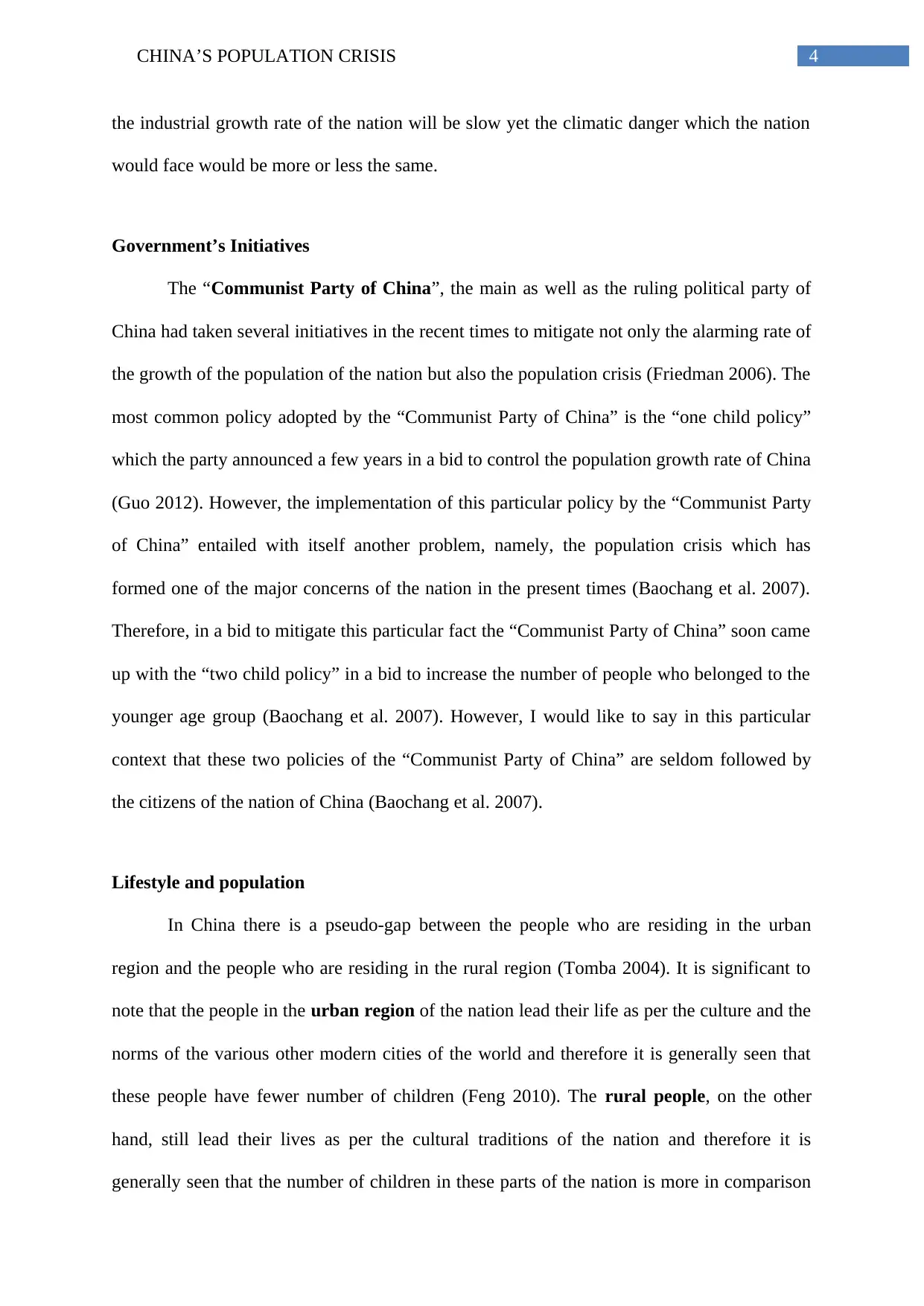
4CHINA’S POPULATION CRISIS
the industrial growth rate of the nation will be slow yet the climatic danger which the nation
would face would be more or less the same.
Government’s Initiatives
The “Communist Party of China”, the main as well as the ruling political party of
China had taken several initiatives in the recent times to mitigate not only the alarming rate of
the growth of the population of the nation but also the population crisis (Friedman 2006). The
most common policy adopted by the “Communist Party of China” is the “one child policy”
which the party announced a few years in a bid to control the population growth rate of China
(Guo 2012). However, the implementation of this particular policy by the “Communist Party
of China” entailed with itself another problem, namely, the population crisis which has
formed one of the major concerns of the nation in the present times (Baochang et al. 2007).
Therefore, in a bid to mitigate this particular fact the “Communist Party of China” soon came
up with the “two child policy” in a bid to increase the number of people who belonged to the
younger age group (Baochang et al. 2007). However, I would like to say in this particular
context that these two policies of the “Communist Party of China” are seldom followed by
the citizens of the nation of China (Baochang et al. 2007).
Lifestyle and population
In China there is a pseudo-gap between the people who are residing in the urban
region and the people who are residing in the rural region (Tomba 2004). It is significant to
note that the people in the urban region of the nation lead their life as per the culture and the
norms of the various other modern cities of the world and therefore it is generally seen that
these people have fewer number of children (Feng 2010). The rural people, on the other
hand, still lead their lives as per the cultural traditions of the nation and therefore it is
generally seen that the number of children in these parts of the nation is more in comparison
the industrial growth rate of the nation will be slow yet the climatic danger which the nation
would face would be more or less the same.
Government’s Initiatives
The “Communist Party of China”, the main as well as the ruling political party of
China had taken several initiatives in the recent times to mitigate not only the alarming rate of
the growth of the population of the nation but also the population crisis (Friedman 2006). The
most common policy adopted by the “Communist Party of China” is the “one child policy”
which the party announced a few years in a bid to control the population growth rate of China
(Guo 2012). However, the implementation of this particular policy by the “Communist Party
of China” entailed with itself another problem, namely, the population crisis which has
formed one of the major concerns of the nation in the present times (Baochang et al. 2007).
Therefore, in a bid to mitigate this particular fact the “Communist Party of China” soon came
up with the “two child policy” in a bid to increase the number of people who belonged to the
younger age group (Baochang et al. 2007). However, I would like to say in this particular
context that these two policies of the “Communist Party of China” are seldom followed by
the citizens of the nation of China (Baochang et al. 2007).
Lifestyle and population
In China there is a pseudo-gap between the people who are residing in the urban
region and the people who are residing in the rural region (Tomba 2004). It is significant to
note that the people in the urban region of the nation lead their life as per the culture and the
norms of the various other modern cities of the world and therefore it is generally seen that
these people have fewer number of children (Feng 2010). The rural people, on the other
hand, still lead their lives as per the cultural traditions of the nation and therefore it is
generally seen that the number of children in these parts of the nation is more in comparison
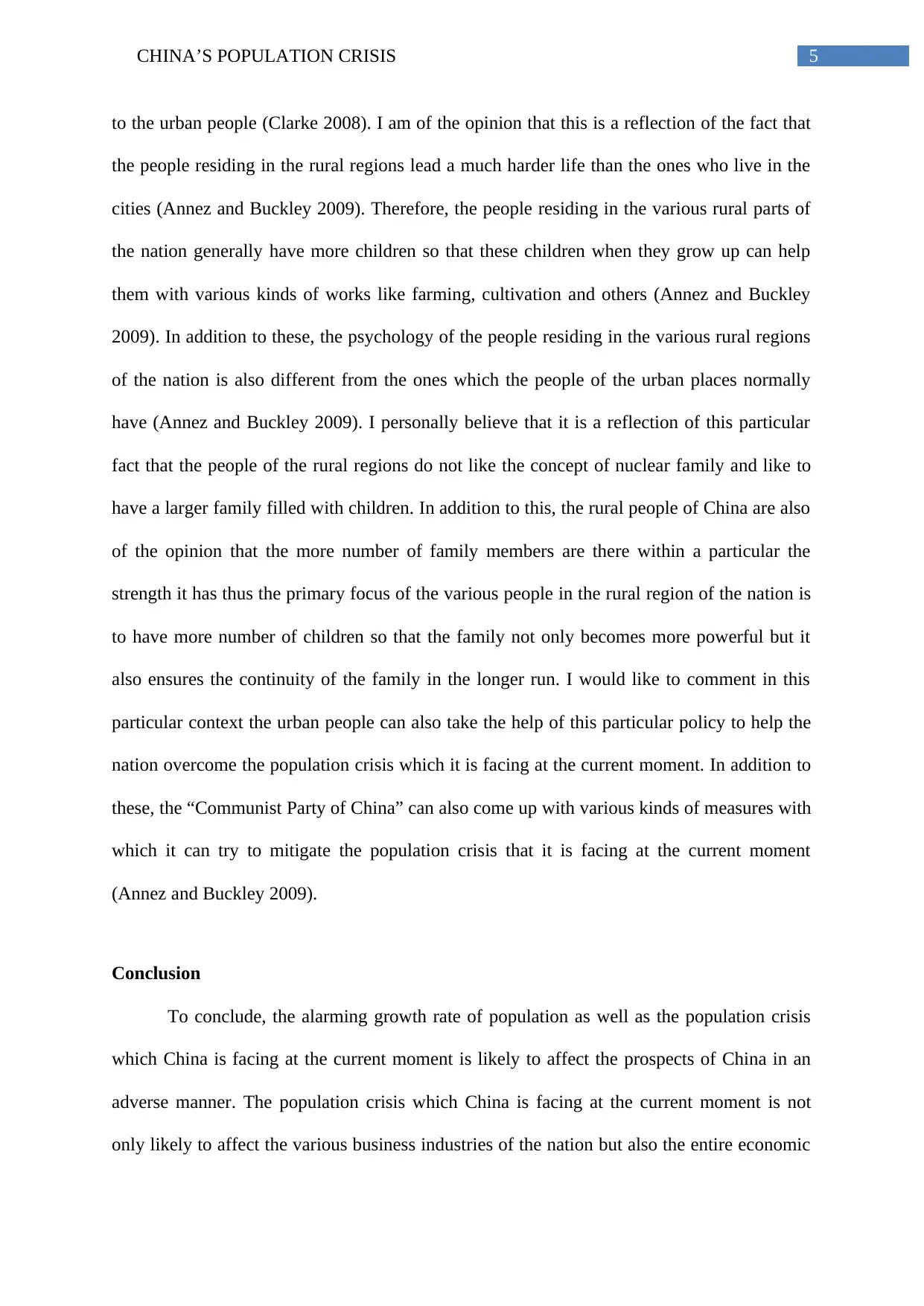
5CHINA’S POPULATION CRISIS
to the urban people (Clarke 2008). I am of the opinion that this is a reflection of the fact that
the people residing in the rural regions lead a much harder life than the ones who live in the
cities (Annez and Buckley 2009). Therefore, the people residing in the various rural parts of
the nation generally have more children so that these children when they grow up can help
them with various kinds of works like farming, cultivation and others (Annez and Buckley
2009). In addition to these, the psychology of the people residing in the various rural regions
of the nation is also different from the ones which the people of the urban places normally
have (Annez and Buckley 2009). I personally believe that it is a reflection of this particular
fact that the people of the rural regions do not like the concept of nuclear family and like to
have a larger family filled with children. In addition to this, the rural people of China are also
of the opinion that the more number of family members are there within a particular the
strength it has thus the primary focus of the various people in the rural region of the nation is
to have more number of children so that the family not only becomes more powerful but it
also ensures the continuity of the family in the longer run. I would like to comment in this
particular context the urban people can also take the help of this particular policy to help the
nation overcome the population crisis which it is facing at the current moment. In addition to
these, the “Communist Party of China” can also come up with various kinds of measures with
which it can try to mitigate the population crisis that it is facing at the current moment
(Annez and Buckley 2009).
Conclusion
To conclude, the alarming growth rate of population as well as the population crisis
which China is facing at the current moment is likely to affect the prospects of China in an
adverse manner. The population crisis which China is facing at the current moment is not
only likely to affect the various business industries of the nation but also the entire economic
to the urban people (Clarke 2008). I am of the opinion that this is a reflection of the fact that
the people residing in the rural regions lead a much harder life than the ones who live in the
cities (Annez and Buckley 2009). Therefore, the people residing in the various rural parts of
the nation generally have more children so that these children when they grow up can help
them with various kinds of works like farming, cultivation and others (Annez and Buckley
2009). In addition to these, the psychology of the people residing in the various rural regions
of the nation is also different from the ones which the people of the urban places normally
have (Annez and Buckley 2009). I personally believe that it is a reflection of this particular
fact that the people of the rural regions do not like the concept of nuclear family and like to
have a larger family filled with children. In addition to this, the rural people of China are also
of the opinion that the more number of family members are there within a particular the
strength it has thus the primary focus of the various people in the rural region of the nation is
to have more number of children so that the family not only becomes more powerful but it
also ensures the continuity of the family in the longer run. I would like to comment in this
particular context the urban people can also take the help of this particular policy to help the
nation overcome the population crisis which it is facing at the current moment. In addition to
these, the “Communist Party of China” can also come up with various kinds of measures with
which it can try to mitigate the population crisis that it is facing at the current moment
(Annez and Buckley 2009).
Conclusion
To conclude, the alarming growth rate of population as well as the population crisis
which China is facing at the current moment is likely to affect the prospects of China in an
adverse manner. The population crisis which China is facing at the current moment is not
only likely to affect the various business industries of the nation but also the entire economic
⊘ This is a preview!⊘
Do you want full access?
Subscribe today to unlock all pages.

Trusted by 1+ million students worldwide
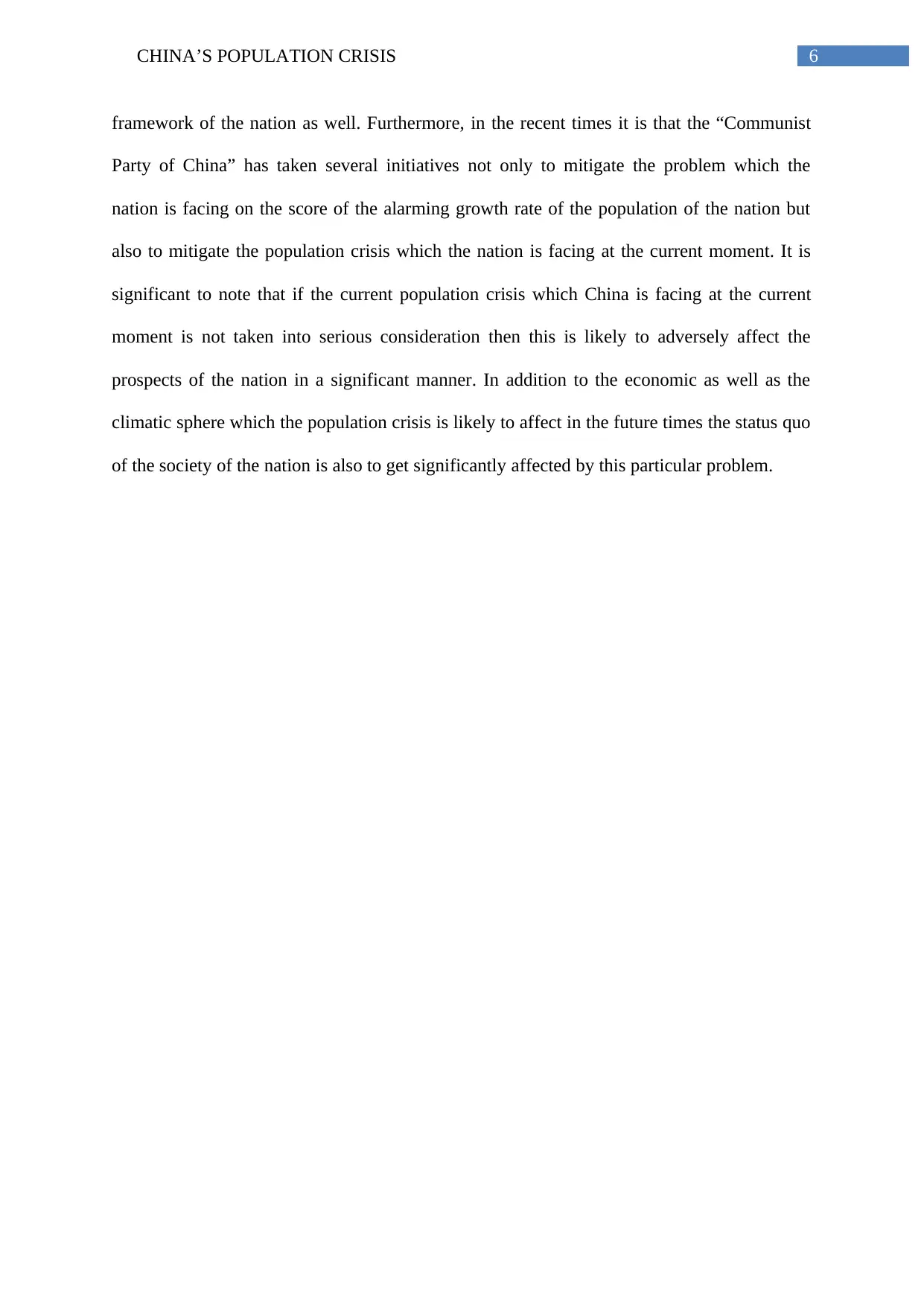
6CHINA’S POPULATION CRISIS
framework of the nation as well. Furthermore, in the recent times it is that the “Communist
Party of China” has taken several initiatives not only to mitigate the problem which the
nation is facing on the score of the alarming growth rate of the population of the nation but
also to mitigate the population crisis which the nation is facing at the current moment. It is
significant to note that if the current population crisis which China is facing at the current
moment is not taken into serious consideration then this is likely to adversely affect the
prospects of the nation in a significant manner. In addition to the economic as well as the
climatic sphere which the population crisis is likely to affect in the future times the status quo
of the society of the nation is also to get significantly affected by this particular problem.
framework of the nation as well. Furthermore, in the recent times it is that the “Communist
Party of China” has taken several initiatives not only to mitigate the problem which the
nation is facing on the score of the alarming growth rate of the population of the nation but
also to mitigate the population crisis which the nation is facing at the current moment. It is
significant to note that if the current population crisis which China is facing at the current
moment is not taken into serious consideration then this is likely to adversely affect the
prospects of the nation in a significant manner. In addition to the economic as well as the
climatic sphere which the population crisis is likely to affect in the future times the status quo
of the society of the nation is also to get significantly affected by this particular problem.
Paraphrase This Document
Need a fresh take? Get an instant paraphrase of this document with our AI Paraphraser
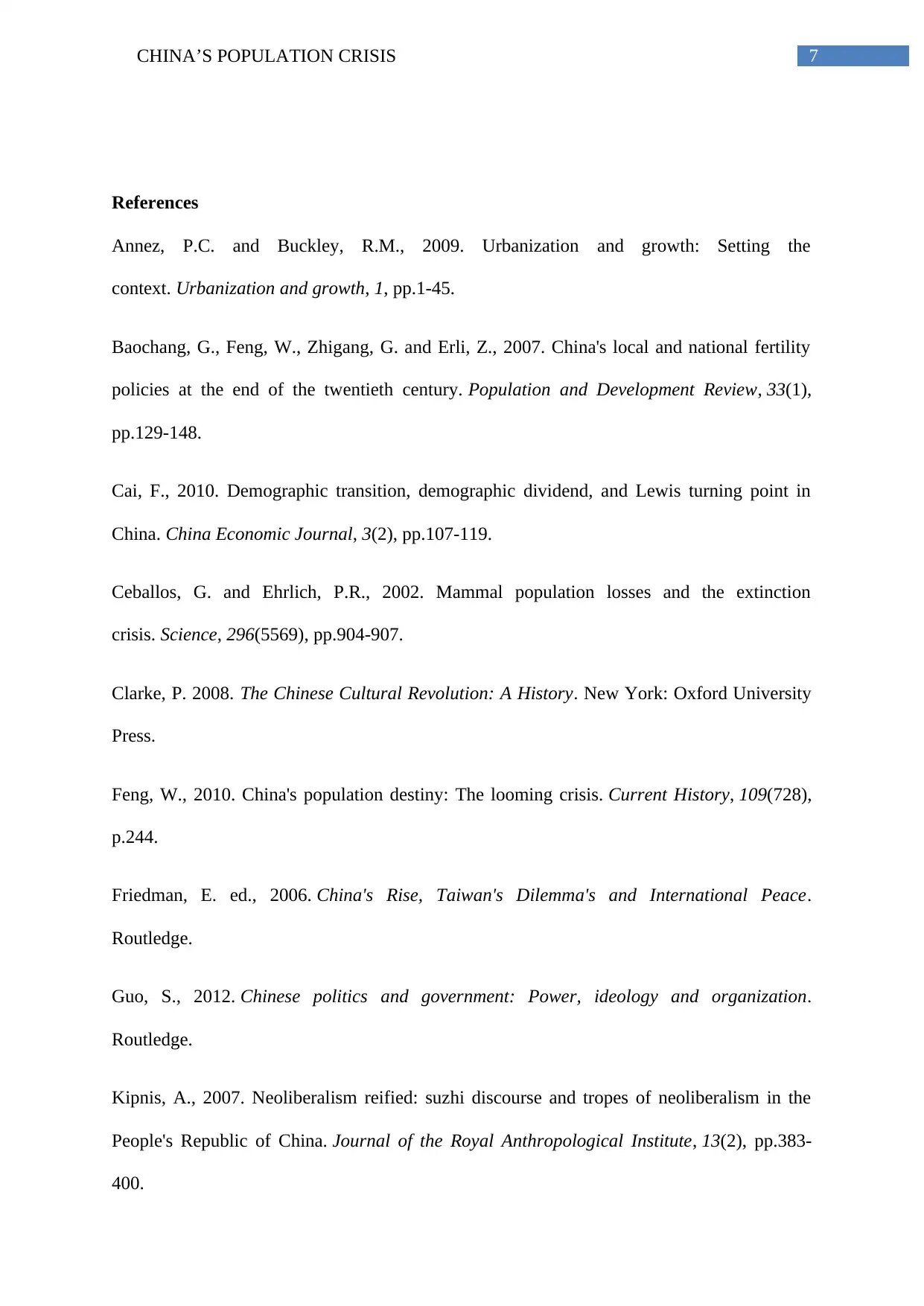
7CHINA’S POPULATION CRISIS
References
Annez, P.C. and Buckley, R.M., 2009. Urbanization and growth: Setting the
context. Urbanization and growth, 1, pp.1-45.
Baochang, G., Feng, W., Zhigang, G. and Erli, Z., 2007. China's local and national fertility
policies at the end of the twentieth century. Population and Development Review, 33(1),
pp.129-148.
Cai, F., 2010. Demographic transition, demographic dividend, and Lewis turning point in
China. China Economic Journal, 3(2), pp.107-119.
Ceballos, G. and Ehrlich, P.R., 2002. Mammal population losses and the extinction
crisis. Science, 296(5569), pp.904-907.
Clarke, P. 2008. The Chinese Cultural Revolution: A History. New York: Oxford University
Press.
Feng, W., 2010. China's population destiny: The looming crisis. Current History, 109(728),
p.244.
Friedman, E. ed., 2006. China's Rise, Taiwan's Dilemma's and International Peace.
Routledge.
Guo, S., 2012. Chinese politics and government: Power, ideology and organization.
Routledge.
Kipnis, A., 2007. Neoliberalism reified: suzhi discourse and tropes of neoliberalism in the
People's Republic of China. Journal of the Royal Anthropological Institute, 13(2), pp.383-
400.
References
Annez, P.C. and Buckley, R.M., 2009. Urbanization and growth: Setting the
context. Urbanization and growth, 1, pp.1-45.
Baochang, G., Feng, W., Zhigang, G. and Erli, Z., 2007. China's local and national fertility
policies at the end of the twentieth century. Population and Development Review, 33(1),
pp.129-148.
Cai, F., 2010. Demographic transition, demographic dividend, and Lewis turning point in
China. China Economic Journal, 3(2), pp.107-119.
Ceballos, G. and Ehrlich, P.R., 2002. Mammal population losses and the extinction
crisis. Science, 296(5569), pp.904-907.
Clarke, P. 2008. The Chinese Cultural Revolution: A History. New York: Oxford University
Press.
Feng, W., 2010. China's population destiny: The looming crisis. Current History, 109(728),
p.244.
Friedman, E. ed., 2006. China's Rise, Taiwan's Dilemma's and International Peace.
Routledge.
Guo, S., 2012. Chinese politics and government: Power, ideology and organization.
Routledge.
Kipnis, A., 2007. Neoliberalism reified: suzhi discourse and tropes of neoliberalism in the
People's Republic of China. Journal of the Royal Anthropological Institute, 13(2), pp.383-
400.
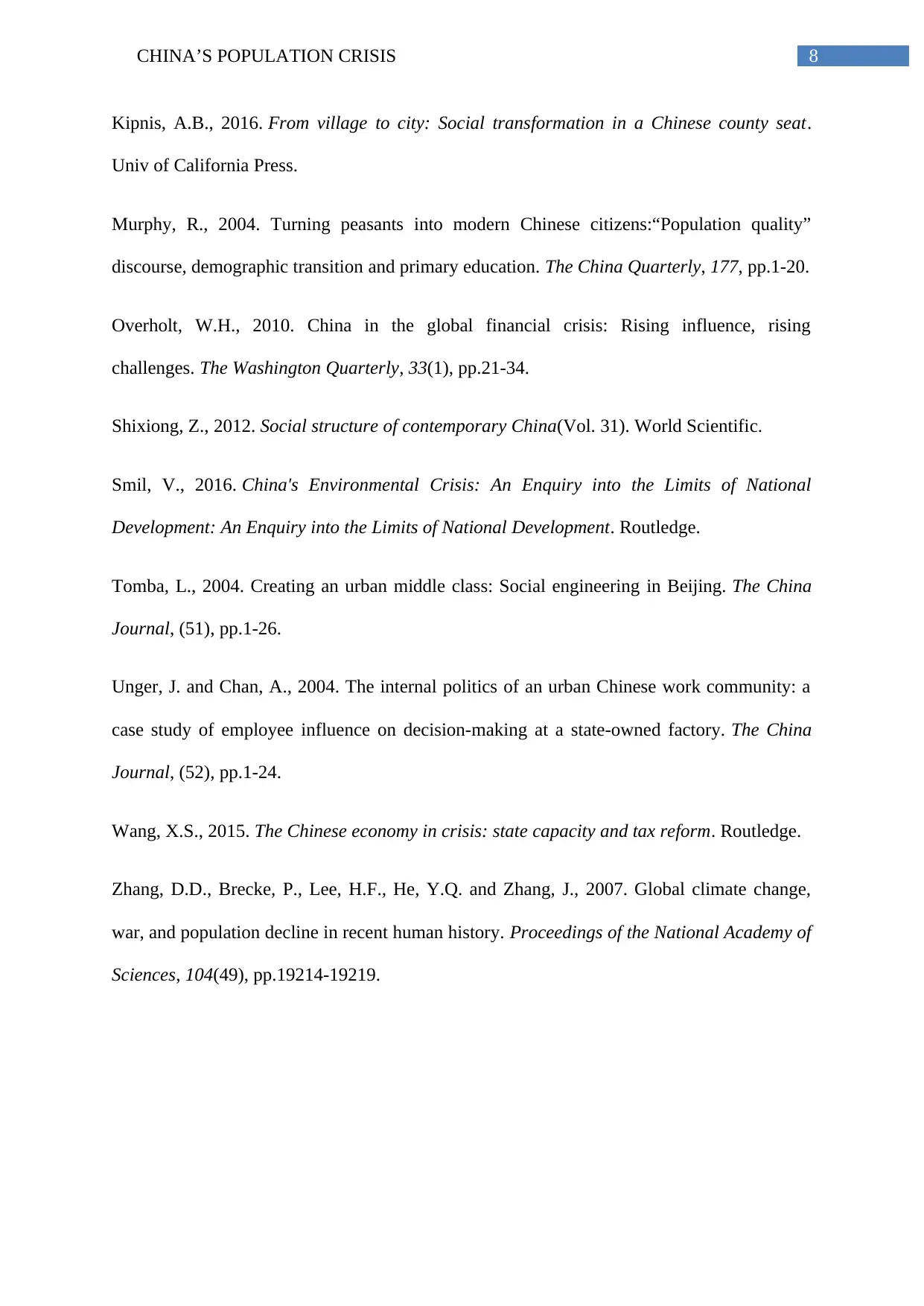
8CHINA’S POPULATION CRISIS
Kipnis, A.B., 2016. From village to city: Social transformation in a Chinese county seat.
Univ of California Press.
Murphy, R., 2004. Turning peasants into modern Chinese citizens:“Population quality”
discourse, demographic transition and primary education. The China Quarterly, 177, pp.1-20.
Overholt, W.H., 2010. China in the global financial crisis: Rising influence, rising
challenges. The Washington Quarterly, 33(1), pp.21-34.
Shixiong, Z., 2012. Social structure of contemporary China(Vol. 31). World Scientific.
Smil, V., 2016. China's Environmental Crisis: An Enquiry into the Limits of National
Development: An Enquiry into the Limits of National Development. Routledge.
Tomba, L., 2004. Creating an urban middle class: Social engineering in Beijing. The China
Journal, (51), pp.1-26.
Unger, J. and Chan, A., 2004. The internal politics of an urban Chinese work community: a
case study of employee influence on decision-making at a state-owned factory. The China
Journal, (52), pp.1-24.
Wang, X.S., 2015. The Chinese economy in crisis: state capacity and tax reform. Routledge.
Zhang, D.D., Brecke, P., Lee, H.F., He, Y.Q. and Zhang, J., 2007. Global climate change,
war, and population decline in recent human history. Proceedings of the National Academy of
Sciences, 104(49), pp.19214-19219.
Kipnis, A.B., 2016. From village to city: Social transformation in a Chinese county seat.
Univ of California Press.
Murphy, R., 2004. Turning peasants into modern Chinese citizens:“Population quality”
discourse, demographic transition and primary education. The China Quarterly, 177, pp.1-20.
Overholt, W.H., 2010. China in the global financial crisis: Rising influence, rising
challenges. The Washington Quarterly, 33(1), pp.21-34.
Shixiong, Z., 2012. Social structure of contemporary China(Vol. 31). World Scientific.
Smil, V., 2016. China's Environmental Crisis: An Enquiry into the Limits of National
Development: An Enquiry into the Limits of National Development. Routledge.
Tomba, L., 2004. Creating an urban middle class: Social engineering in Beijing. The China
Journal, (51), pp.1-26.
Unger, J. and Chan, A., 2004. The internal politics of an urban Chinese work community: a
case study of employee influence on decision-making at a state-owned factory. The China
Journal, (52), pp.1-24.
Wang, X.S., 2015. The Chinese economy in crisis: state capacity and tax reform. Routledge.
Zhang, D.D., Brecke, P., Lee, H.F., He, Y.Q. and Zhang, J., 2007. Global climate change,
war, and population decline in recent human history. Proceedings of the National Academy of
Sciences, 104(49), pp.19214-19219.
⊘ This is a preview!⊘
Do you want full access?
Subscribe today to unlock all pages.

Trusted by 1+ million students worldwide
1 out of 9
Your All-in-One AI-Powered Toolkit for Academic Success.
+13062052269
info@desklib.com
Available 24*7 on WhatsApp / Email
![[object Object]](/_next/static/media/star-bottom.7253800d.svg)
Unlock your academic potential
Copyright © 2020–2025 A2Z Services. All Rights Reserved. Developed and managed by ZUCOL.
